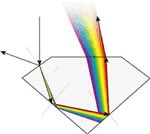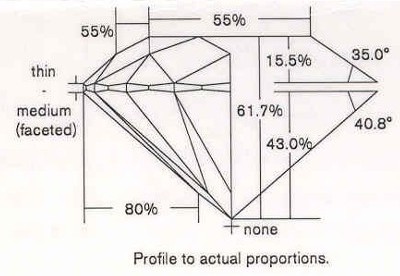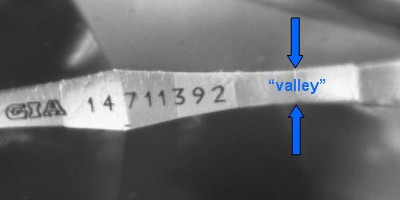![]() After 15 years of research, the GIA released a new cut grade system in January of 2006. Under the new system, cut (for round brilliant diamonds only) is determined and assigned one of five cut grades (Excellent, Very Good, Good, Fair and Poor).
After 15 years of research, the GIA released a new cut grade system in January of 2006. Under the new system, cut (for round brilliant diamonds only) is determined and assigned one of five cut grades (Excellent, Very Good, Good, Fair and Poor).
The GIA’s new cut grade system uses a predictive computer model to estimate a diamond’s brilliance and beauty based on its interrelated specifications. The model was derived from evaluating 70,000 individual diamond observations. In other words, numerous people in various lighting conditions viewed diamonds with different cut specifications and their perceptions of fire and brilliance were recorded along with the diamond’s specifications.
The preliminary cut research focused on a computer model of the way light behaves within a three-dimensional round brilliant diamond. However, they determined that computer modeling alone could not evaluate several important visual components effectively. Thus, the GIA incorporated human observations to evaluate brightness, fire and overall cut appearance.
The GIA Diamond Cut Grading System is based on an assessment of seven components. The first three are appearance based (Brightness, Fire, and Scintillation) and the remaining four (Weight Ratio, Durability, Polish, and Symmetry) are related to design and craftsmanship.
Appearance Factors
Brightness is the visual effect of all the internal and external reflections of white light. This brightness (often called brilliance), is impacted primarily by the cut proportions of the diamond. In other words, a diamond with exceptional cut can be brighter than a diamond with higher color and clarity but lesser cut proportions. The cut proportion components that have the greatest impact on brightness and brilliance are the table percentage, crown angle and pavilion angle.
 Fire is the visual effect of flashes of color caused by white light being separated into a rainbow of colors as the diamond acts like a prism. Fire is the most difficult of a diamond’s visual characteristics to measure or assess.
Fire is the visual effect of flashes of color caused by white light being separated into a rainbow of colors as the diamond acts like a prism. Fire is the most difficult of a diamond’s visual characteristics to measure or assess.
Scintillation is the visual effect of sparkle and patterns of light and darkness. Sparkle is the points of light that flash as the light source, the diamond, or the observer moves. Even and balanced sized sparkle is considered more visually appealing. The internal and external reflections of light in a diamond create patterns of size, arrangement and contrast between the brightness and dark areas.
The GIA provides their predictive model as a free online service, known as GIA Facetware™. To estimate a cut grade for a round brilliant diamond, GIA Facetware™, requires the input of the following parameters:
- Total depth percentage (nearest 0.1%)
- Table percentage (nearest 1%)
- Crown angle (nearest 0.5 degree)
- Pavilion angle (nearest 0.2 degree)
- Star length (nearest 5%)
- Lower-half (lower-girdle facet) length (nearest 5%)
- Girdle thickness (visually assessed by GIA grader)
- Culet size (visually assessed by GIA grader)
- Polish grade (visually assessed by GIA grader)
- Symmetry grade (visually assessed by GIA grader)
GIRDLE THICKNESS AND THE GIA CUT GRADE
| Thinnest Portion | Thickest Portion | |||||||
| ExThin | VThin | Thin | Medium | SlThick | Thick | VThick | ExThick | |
| Ext Thin | GD | VG | VG | VG | VG | VG | GD | FR |
| Very Thin | VG | VG | VG | VG | VG | GD | FR | |
| Thin | VG | VG | VG | VG | GD | FR | ||
| Medium | VG | VG | VG | GD | FR | |||
| Slightly Thick | VG | VG | GD | FR | ||||
| Thick | VG | GD | FR | |||||
| Very Thick | GD | FR | ||||||
| Ext Thick | FR | |||||||
FINISH AND THE GIA CUT GRADE
| Finish (Polish & Symmetry) | Highest Cut Gade Obtainable |
| Excellent, Very Good | Excellent |
| Good | Very Good |
| Fair | Good |
| Poor | Poor |
CULET SIZE AND THE GIA CUT GRADE
| Culet Size | Highest Cut Gade Obtainable |
| None, Very Small, Small | Excellent |
| Medium | Very Good |
| Slightly Large, Large | Good |
| Very Large | Fair |
| Extremely Large | Poor |
GIA Facetware™ Cut Estimator
The GIA Facetware™ Cut Estimator is provided as an estimation of the cut grade that would be assigned by the GIA Laboratory. However, the actual grade assigned by the GIA can be slightly different depending on factors such as:
- Accuracy and tolerances of measuring equipment
- Visually assessed parameters (such as girdle thickness and symmetry)
- Non-standard facet cutting techniques and styles (such as painting or digging out)
GIA ReportCheck
The GIA Laboratory collected the necessary proportion information on most round brilliant diamonds they graded in 2005. So even though the GIA cut grades were not included on the Diamond Grading Reports and Diamond Dossier Reports until January 1, 2006, the cut grade information is available online at www.GIA.edu/reportcheck for round brilliant diamonds graded by the GIA in 2005. By inputting the report number and carat weight for a specific diamond, the cut grade and associated proportion information is displayed.
Diamond Components
Diameter of a round diamond is the distance measured to 0.01 millimeters, between opposite edges of the girdle’s outline. Since round diamonds are not perfectly round, the measurements are taken at several points around the diamond and the average diameter is calculated as the sum of the minimum and maximum divided by two: (min+max)÷2.
Table Size Percentage is the average width of the table divided by the average diameter with the resulting percentage expressed to the nearest 1%. The table size is measured from the bezel point to bezel point for each of the four lengths. The average is calculated by dividing the sum of those measurements by four.
Crown Angle is calculated as the average of the eight crown angles with the average expressed to the nearest half a degree (0.5°). The crown angle is measured as the angle of the bezel facet plane to the table facet plane.
Pavilion Angle is calculated as the average of the eight pavilion angles, expressed to the nearest tenth of a degree (0.1°). The pavilion angle is the angle of the pavilion main facet plane relative to the plane of the table.
Star Length Percent is calculated a the average of the eight ratios, expressed to the nearest five percent (5%). The star length ratio is the perceived distance from point of star facet to the table divided by the distance from girdle to table when looking down at the diamond (perpendicular to the table).
Lower-Half Percent is calculated as the average of the eight lower-half ratios expressed to the nearest five percent (5%). The lower-half ratio is the perceived distance from girdle to point where two pavilion main facets meet, divided by the radius when looking at the bottom of the diamond (perpendicular to the table).
Crown Height Percent is calculated as the average of the eight crown height ratios expressed to the nearest half a percentage (0.5%). Crown height ratio is measured as the distance from the table plane to the girdle plane at the bottom of the bezel facet, divided by the average diameter.
Pavilion Depth Percent is calculated as the average of the eight pavilion depth ratios expressed to the nearest half a percentage (0.5%). The pavilion depth ratio is measured as the distance from the girdle plane at the top of the pavilion main to the culet divided by the average diameter.
Total Depth is the distance from the table plane to the culet expressed to the nearest hundredth of a millimeter (0.01 mm).
Total Depth Percent is calculated as the total depth divided by the average diameter, expressed to the nearest tenth of a percentage (0.1%).
Girdle Thickness is a verbal description of the range from thinnest to thickest for the “valley” areas of the girdle. Descriptions include Extremely Thin, Very Thin, Thin, Medium, Slightly Thick, Thick, Very Thick, and Extremely Thick. Extremely thin appears as a knife-edge with no visible girdle between crown and pavilion. The descriptions are relative to the size of the diamond (i.e., diameter). In other words, the millimeter thickness that produces a Thick rating on a half-carat diamond might be assigned a Thin rating for a five-carat diamond.
Culet Size is a verbal description of the average width of the culet relative to the average diameter. Descriptions include None, Very Small, Small, Medium, Slightly Large, Large, Very Large, and Extremely Large. The None (also referred to as pointed), Very Small and Small ratings are generally not visible to the eye.
Painting and Digging Out are factors that the GIA Laboratory takes into consideration for determining cut grade but are not included in the GIA Facetware™ Cut Estimator.
Painting and Digging Out
Painting and Digging Out are terms that describe faceting techniques for the half facets that influence their three-dimensional positioning (relative positions, angles to the horizontal, and distances from the center of the diamond). The painting and digging out techniques are typically used to save weight during the cutting process, to remove inclusions near the girdle, or to influence the face-up appearance of the diamond.
In a standard girdle profile, the girdle “hills” are roughly equal where the bezel facets meet the pavilion mains compared to where the upper and lower half facets meet.
With the “painted” techniques, the girdle “hills” where the upper and lower half facets meet are thicker than where the bezel facets and pavilion mains meet.
With the “”dug out” technique, the girdle “hills” where the upper and lower half facets meet are thinner than where the bezel facets and pavilion mains meet.
The impact of Painting and/or Digging Out on cut grade is influenced by the relative visibility of the technique and whether it is used only on the crown, only on the pavilion or on both.


